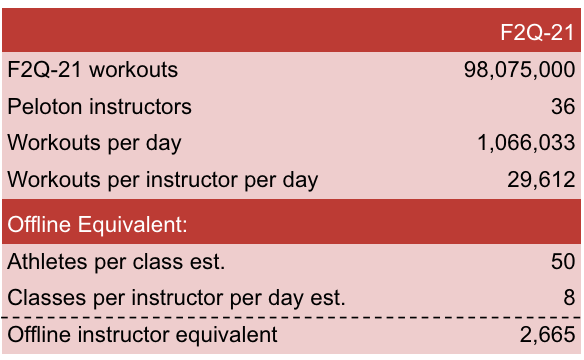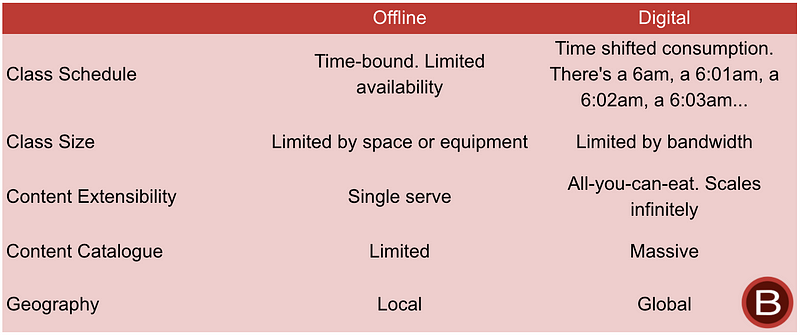Peloton's Digital Revolution: How Fitness is Transforming Online
Written on
Chapter 1: The Thanksgiving Surge
Side dishes often steal the show at Thanksgiving, with favorites like candied yams and stuffing delighting diners. In 2020, while families enjoyed their turkey, 88,000 Peloton users engaged in cycling workouts. The demand for Peloton’s Turkey Burn sessions could have filled MetLife Stadium, which has a capacity of 82,500. This scenario exemplifies how the evolution of business models, along with the constraints and opportunities associated with them, is shifting as more activities migrate online.
Keeping Emma Engaged
The internet allows for a scale that traditional methods cannot match. Peloton employs 36 fitness instructors, and in Q4 of 2020, the platform recorded 98 million workouts. This translates to an impressive average of 30,000 participants per instructor daily, enough to fill Madison Square Garden multiple times. In contrast, facilitating 98 million workouts offline would necessitate a vast number of instructors—far beyond Peloton's current staffing.

Source: Peloton F2Q-21 Earnings. Note: F2Q-21 represents the quarter ending December 31, 2020.
With a modest number of instructors, Peloton caters to a vast online audience. Back in September 2017, Peloton had only 11 instructors and logged 2.5 million workouts per quarter. By the end of 2020, the number of workouts skyrocketed to 98 million, a staggering increase of 3,800%. During this same period, the instructor count rose by 227%, from 11 to 36, demonstrating that scaling like this is only feasible in an online environment.

Source: Peloton S1, Peloton F2Q-21 Earnings, Peloton Instructor Page, and Reddit.
To Infinity and Beyond
Transitioning to an online model transforms industry constraints and economics. Offline fitness studios are limited by physical space; for instance, a yoga studio can only accommodate a set number of mats. Likewise, spinning classes have fixed seating, and if one person books a bike, another cannot use it simultaneously. Geographic restrictions also play a role, as gyms are typically located near one’s home or workplace. Additionally, offline classes adhere to rigid schedules, making it difficult to find sessions at specific times.
The online format eliminates these constraints. Peloton’s 88,000 participants in the Turkey Burn demonstrate that class size can be virtually limitless. Online workouts can be infinitely scaled (as long as participants have a bike). Bandwidth is now the primary constraint, but it remains abundant and affordable, thanks to platforms like AWS. Location is no longer a barrier; whether you're in Ames, Iowa, or Anchorage, Alaska, you can join a workout filmed anywhere in the world. Schedules become adaptable as well, with past sessions available for streaming at any time. Finally, workouts become an all-you-can-eat buffet; content produced once can be monetized indefinitely.

Pump Up the Volume
Digital products typically incur high fixed costs but have low marginal costs. While serving the first subscriber may be expensive, the cost of adding subsequent customers is minimal. Establishing a tech platform and content library demands significant upfront investments, as Peloton had to onboard designers, engineers, fitness instructors, and content producers. However, these salaries remain constant regardless of the number of workouts or subscribers. Similarly, production costs do not change whether a workout is streamed once or thousands of times. As subscriptions increase, the initial investment is diluted across a larger user base.
Peloton generates revenue through hardware sales, like bikes and treadmills, and monthly streaming subscriptions. The subscription model takes advantage of the fixed cost structure. According to CFO Jill Woodworth, about 50% of content development costs are fixed, meaning as the volume of workouts and subscriptions rises, these costs remain steady. The other 50% of subscription expenses, such as music royalties and streaming fees, are variable and increase with usage.
The potential for revenue growth is substantial, as fixed costs can be spread over a larger number of subscribers. For instance, between Q2 2019 and Q4 2020, Peloton's workouts increased by 450%, while the instructor count only rose by 24%. This disparity leads to a significant drop in per-workout costs.

Source: Peloton Media Assets. Peloton instructor Alex Toussaint, presumably saying, “bring on the operating leverage.”
Sorry SoulCycle
The scalability and fixed cost nature of digital platforms alter the investment landscape. Traditional spinning studios are constrained by a limited number of bikes and classes, restricting their ability to invest in instructors and facilities. In contrast, online classes are infinitely scalable and not limited by time or geography, allowing businesses to allocate more resources towards growth. This increased capacity enhances reach and class sizes, and the ability to invest more significantly surpasses that of offline counterparts.
In a New York Times feature, Robin Arzón, Peloton’s VP of fitness programming, compared teaching at Peloton to working at a traditional fitness studio, stating that it’s “the difference between standing with a megaphone in Union Square and getting on the soundstage at the ‘Today’ show.” The online strategy focuses on investing heavily in content and customer acquisition, aiming to achieve high volumes over fixed costs. This is similar to Netflix's annual content expenditure of over ten billion dollars. Peloton has also invested in high-quality production studios and offers competitive salaries and benefits to instructors.
In digital markets, major players like Amazon, Google, and Netflix dominate, while niche services remain relevant on the other end. The dynamics of fixed costs mean that as platforms grow, they tend to attract more subscribers, which allows for further investment in content. The competition for consumer attention increases as companies like Peloton raise the bar for what users can expect from a $39 monthly subscription.
Peloton has positioned itself as the leader in connected fitness, yet the future of online fitness remains uncertain. While Peloton enjoyed impressive growth in 2020, it is essential to consider the impact of Covid-19 lockdowns that forced many to turn to home workouts. If fitness follows the patterns of other digitized industries, there is still a place for boutique fitness and personal trainers. However, the outlook for mid-tier businesses like Barry’s Bootcamp, Equinox, and SoulCycle may not be as optimistic. Having already faced challenges during the pandemic, they might find themselves struggling to compete in the current landscape.
For more insights like this, check out my newsletter on Substack.

Source: Peloton Media Assets
This video provides a straightforward solution for Peloton bikes that won't turn on, helping users troubleshoot and fix their equipment.
In this video, learn how to replace the touchscreen on your Peloton bike, ensuring you stay connected to your workouts.